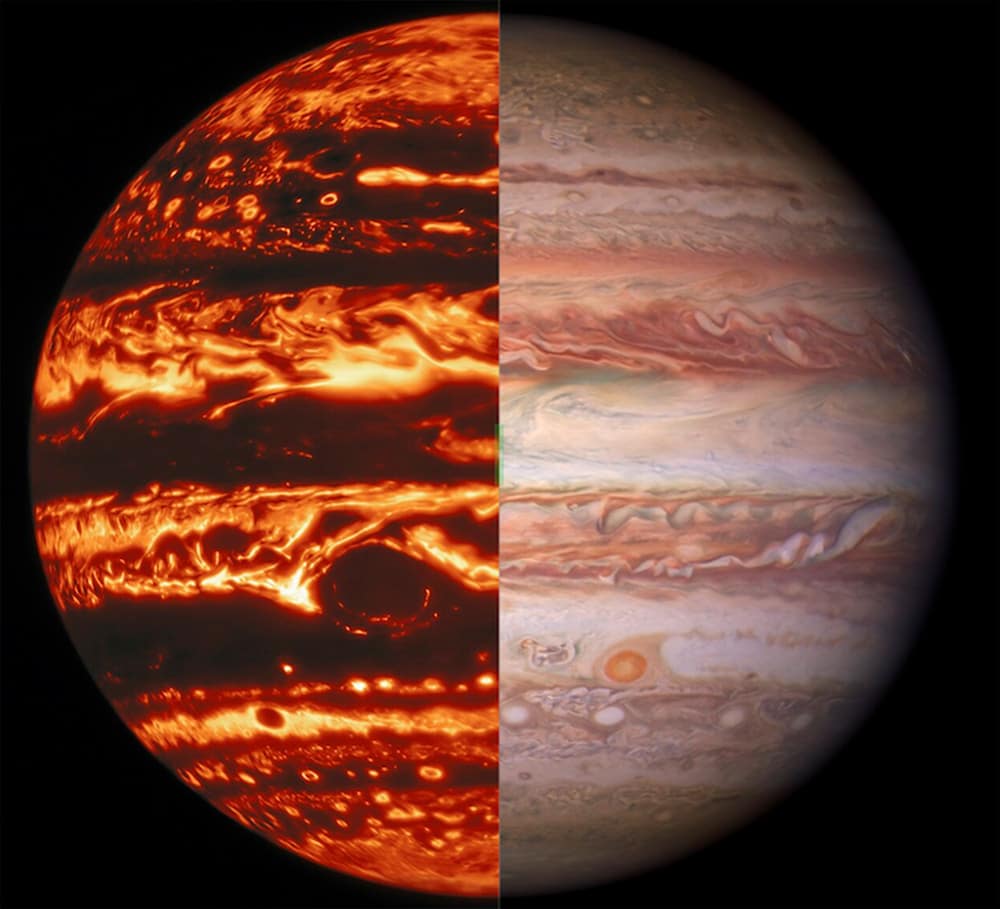Data from NASA’s Juno spacecraft is providing a deeper understanding of Jupiter’s wondrous and violent atmosphere including its Great Red Spot, finding that this immense swirling storm extends much further down than expected.
Researchers on Thursday said the Great Red Spot plunges between roughly 350 to 500 kilometres below the cloud tops on Jupiter, based on microwave and gravity measurements obtained by Juno.
The data is giving scientists studying the solar system’s largest planet – so big that 1000 Earths could fit inside it – a three-dimensional account of Jupiter’s atmosphere.
The planet, known as a gas giant, is composed primarily of hydrogen and helium, with traces of other gases. Stripes and a few storms like the Great Red Spot dominate the colourful appearance of Jupiter, the fifth planet from the sun with a diameter of about 143,000km.
The Great Red Spot is a storm about 16,000km wide churning in Jupiter’s southern hemisphere, boasting crimson-coloured clouds that spin anti-clockwise at high speeds.
It is one of the marvels of the solar system and has been in existence for centuries, but scientists until now have had little understanding of what lies below its surface.
“From a scientific point of view, it’s puzzling how the storm can last so long and be so big,” said Scott Bolton, principal investigator of the Juno mission at the Southwest Research Institute in Texas and lead author on one of two Jupiter studies published in the journal Science on Thursday.
“It is wide enough to swallow the Earth,” added Marzia Parisi, a Juno scientist from NASA’s Jet Propulsion Laboratory in California and lead author of the second study.
An instrument called a microwave radiometer enabled scientists to peer beneath Jupiter’s cloud tops and investigate the structure of its numerous vortex storms including the Great Red Spot, showing that they exist very deep in Jupiter’s atmosphere – much deeper than expected.
Rather than being confined to the uppermost parts of Jupiter’s atmosphere, the Great Red Spot’s roots plunge to regions beyond where water condenses and clouds form – and below where any sunlight reaches.
Juno data previously showed that jet streams in Jupiter’s atmosphere reach down even further, to depths of about 3200km.
Assumptions based on how Earth’s atmosphere behaves, as well as models produced over past few decades, had given the impression that the Great Red Spot was a relatively shallow storm.
“Jupiter works in this mysterious way that we’re sort of revealing for the first time – because this is the first mission that’s been able to look inside the planet,” Bolton said.
“And we’re seeing surprises.”
Jupiter and Earth are vastly different worlds, and not just in terms of size. Earth is a rocky place. Jupiter lacks a solid surface though it may have a solid inner core.
Juno has been orbiting Jupiter since 2016, obtaining information about its atmosphere, interior structure, internal magnetic field and the region around it created by its internal magnetism. Juno also is due to fly by Jupiter’s large moons Europa and Io and explore the small rings around the planet.
The Great Red Spot has evolved in shape over time and there are indications that it may be shrinking in size.
“It’s the biggest storm in the entire solar system. There isn’t anything else like it,” Bolton said.
“The extremes are usually fascinating but they also create incredible beauty.”
AAP
Get all the latest Canberra news, sport, entertainment, lifestyle, competitions and more delivered straight to your inbox with the Canberra Daily Daily Newsletter. Sign up here.



